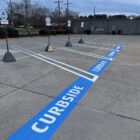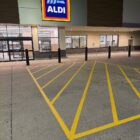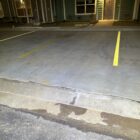frequently asked questions
Lot striping and traffic markings refer to the lines, symbols and signage applied directly to parking lot asphalt. Properly designed and applied striping can help define the boundaries of individual parking spots, alert drivers to fire lanes or pedestrian crossing zones, direct traffic in a specific way to maximize efficiency and more.
Vibrant and properly applied parking lot striping serves many purposes. In addition to boosting curb appeal, it helps improve safety for drivers and pedestrians, enhances traffic flow, optimizes available space, enables more accessibility and ensures compliance with all local and federal regulations.
Even the best striping won’t last forever. How often your parking lot needs a refresh will depend on weather exposure and traffic volume, but most contractors recommend getting fresh paint every 18 to 24 months to maintain visibility.
All parking lots need a specific number of accessible parking spots and access aisles to meet standards set by the Americans with Disabilities Act (ADA). The exact number required will depend on the number of traditional spots your lot holds, but a good rule of thumb is to plan for one accessible space for every 25 spots. It’s also important to consider other factors that impact ADA compliance, such as the availability of access lanes, proper sizing, etc.
There are many options available, covering any property owner’s needs and budget. Low-cost paint formulas include water-, oil- and solvent-based options with an average lifespan of about two years. More expensive alternatives like thermoplastic line markings are available, and they offer great longevity, more flexibility and years of vibrancy.
Weather conditions can impact the application and curing process. The best time to apply parking lot striping paint is when it’s warm and dry. Most contractors recommend investing in striping or restriping services during the spring and summer seasons when the average temperature is above 50 degrees Fahrenheit and the humidity is manageable.
More affordable and conventional paint formulas rely on evaporation to cure, and most are ready for traffic an hour after application. However, weather conditions can lengthen the curing time. Thermoplastic paint cures as it cools, taking as little as five minutes regardless of the temperature and humidity.
Contractors can remove faded striping with specialty equipment. It’s also possible to cover old markings with fresh sealcoating. Once covered, teams can apply a new design that better suits your property’s needs.
The best way to keep striping in good shape is to clean regularly. Taking time to remove debris, pick up trash and wash away grime can eliminate chemicals and salt that result in premature fading. Regular maintenance tasks like sealcoating can also play a big role in keeping stripes fresh.
While parking lot striping looks simple, it requires extensive knowledge and experience to do things correctly. Contractors have years of experience and access to powerful equipment that can create precise lines in a fraction of the time it’d take to DIY. Furthermore, contractors understand what your lot needs to comply with codes and regulations and how to ensure the results of their work last as long as possible.



